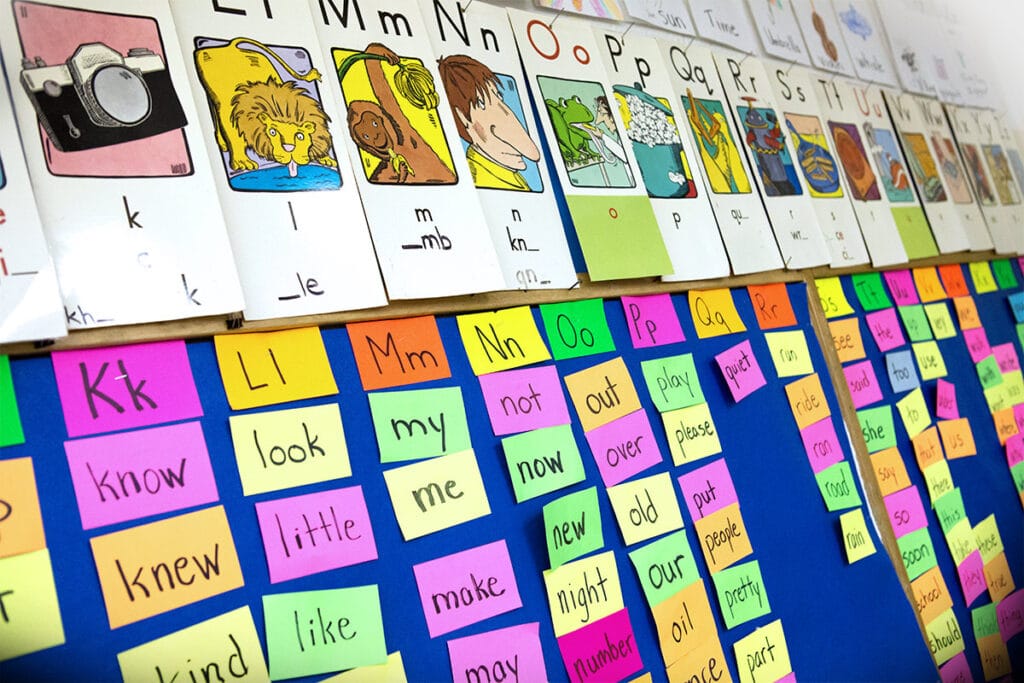The Word Wall is the place in your classroom where high-frequency words are housed after you have taught them (other important words such as vocabulary or theme words should be posted elsewhere). The Word Wall serves as a visual reminder and reference tool for your students that they can use whenever they read or write. A Word Wall makes it possible for children to write conventionally without asking for help, allowing them to be more independent and less dependent on you.
When children can spell these high-frequency words correctly and with automaticity, it frees them to concentrate on applying themselves to the content of their pieces or on spelling more challenging words. Incidentally, as children peruse the Word Wall in search of the word they are looking for, they end up reading and reviewing several other important words as well. The Word Wall also give children practice with visual discrimination, an important building block for reading. For example, the words the, their, these, and there all look similar; however, when they are posted near one another, children can see how each letter’s spot creates a very different word.
Where should I place the Word Wall in my room?
Place the Word Wall where children can easily see the words and reach them. Children need to be able to touch the word they reference, at least with a pointer if not with their hand, because that way someone can give them feedback that they have indeed found the correct word! This makes the learning concrete, something our young and struggling readers need.
Also, you will be less likely to add words to the Word Wall on a regular basis if you have to climb on furniture to access it.
How do I create an effective Word Wall?
- Use a dark background to make the letter and word cards “pop.”
- Use white 3×5 cards with the upper and lower case letters written in black marker. Letter cards should be a different color than word cards. This visually teaches children that letters are distinct from words.
- Display the letter cards in one long line, Aa-Zz, to emphasize the alphabetic principal. This makes it easier for emergent and struggling readers to find a particular letter because it is placed in its spot in the ABCs. Also, you won’t run out of space for words under any given letter if there isn’t a second row underneath.
- Use varied colored 3×5 cards for your Word Wall words to facilitate easier tracking and copying of the word during independent writing. If a child can’t find a certain word, a friend can help by saying, “It’s on a green card, under…Rr.”
- Write the Word Wall words in large, black letters. Black ink contrasts well with the colored cards. Handwritten words allow them to be as large as possible, thus making it easier for children to be able to see the words from anywhere in the room.
- Refer to the Word Wall throughout the instructional day. Teach children how to use it as a reference so they learn how to use it independently. Play Word Wall games to get children comfortable with finding words and familiar with the words that are on the Word Wall.
- A good rule of thumb is to choose approximately 3-5 new words a week to introduce to your students. You can select these words from the students’ writing (what high-frequency words are they using and misspelling most often?) or from common high-frequency word lists such as the Dolch List (which has the most common 220 high-frequency words) or the more recent Fry list which has 1000 high-frequency words. Once you have selected and written your words on index cards, follow these steps when introducing each word:
- Show and say the word.
- Use the word in context (i.e. in a sentence)
- Then, have children say the word, chant the letters of the word, and write the word on a piece of paper or on a wipe off board.
- Engage the students in saying and spelling the word through multisensory activities such as clapping each letter or jumping up and down as they say each letter throughout the week. Do a fun activity at least once each week to reinforce their use.
The Word Wall and Spanish Language Classrooms
Since small words are generally easy to sound out and spell in Spanish, it can be argued that an A-Z Word Wall is not necessary for a Spanish language classroom. Rather, words could be grouped by their spelling, such as words spelled with c/s/z; words with silent h; and, words spelled with ll or y, etc.
Still, if you are seeing frequent misspellings of common words, a bank of words organized alphabetically can be key to supporting and keeping your children accountable for reading and spelling these words.



